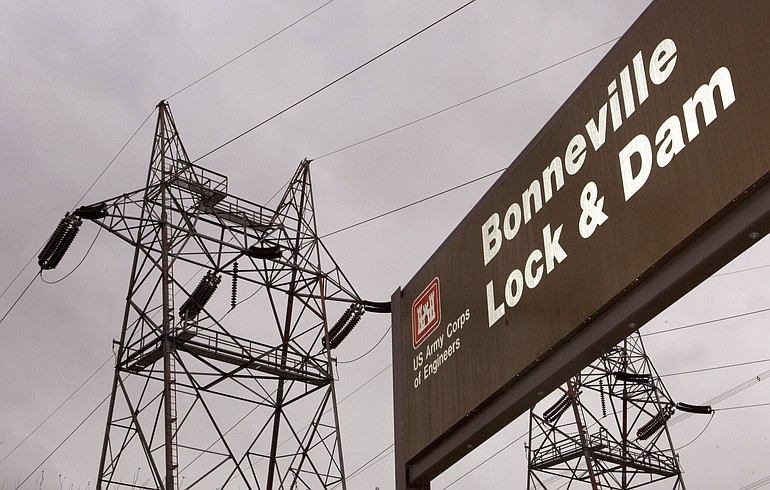A proposed high-voltage transmission line continues to generate plenty of concern among Clark and Cowlitz county residents, despite the Bonneville Power Administration adding a new alternative running primarily through state and industrial forest land.
Bonneville bowed to public pressure in adding the new alternative to the north and east away from populated areas. However, by shifting segments away from campsites and trails proposed in the Yacolt Burn State Forest, Bonneville added other alternatives that affect an extra 300 to 400 living on the forest’s western edge.
Many turned out during BPA’s latest public meeting, at Skyview High School in Salmon Creek on Tuesday night.
“Is an ATV trail more important than homes?” Battle Ground area resident Bryan Call asked.
Larry Bekkedahl, BPA’s vice president of engineering and technical services, fielded questions during the Skyview event on Tuesday. He also visited a business-friendly audience at the Vancouver Rotary Club over the lunch hour on Wednesday.
“We are certainly not going to please everybody,” Bekkedahl told the business group. “Is there any one answer that’s going to be perfect? No. And is it going to be easy? No.”
Bonneville is proposing to string a 500-kilovolt transmission line between new substations in Castle Rock and Troutdale, Ore. The project, financed by increased borrowing authority granted by Congress last year, is expected to cost about $400 million. The existing grid has become congested to the point that federal officials say they will need the new line by 2018 or risk blackouts.
“I don’t want to be the one who chooses which part of the system is not going to be energized,” Bekkedahl told the crowd at Skyview.
BPA administrator Steve Wright is due to make a final decision in 2012.
In the meantime, agency employees are analyzing dozens of segments within corridors as wide as a mile across.
Despite the lingering uncertainty for thousands of landowners in Southwest Washington, Bonneville officials were definitive on one point: They aren’t thinking about sending the line down the Oregon side of the Columbia River, even though Portland is driving the bulk of the region’s load growth.
Bonneville did consider a route from Longview to an existing BPA substation near Wilsonville, Ore., but dropped it last year after identifying too many environmental and technical obstacles.
BPA officials said the wide river crossing downstream from Longview would have required towers as tall as 400 feet, illuminated by strobe lights in sensitive wildlife habitat. Further, BPA had no existing rights of way in Oregon; by contrast, one of the agency’s alternatives in Washington parallels an existing 230-kilovolt line along Interstate 5. Finally, BPA officials say, they have no room to expand their Pearl substation in Wilsonville, whereas they do have room in Troutdale.
Given the urgency of the timeline and the thorough study required for each alternative, BPA project manager Mark Korsness said it makes sense to focus on the most promising alternatives.
And those happen to be in Washington, he said.
Even so, all six county commissioners for Clark and Cowlitz last week signed a letter calling on Wright to reconsider routing the line through Oregon.
“We respectfully request that the BPA reconsider its decision to remove the Pearl Alternatives from further consideration and analysis,” they wrote in the letter dated Aug. 26. “Our two governments are convinced that the best way to reach a balanced public process is to include the Oregon-based Pearl Alternatives in the debate.”
The group called for BPA to host a series of public meetings to explain specifically why the Oregon route was ruled out.
“We cannot emphasize enough how BPA’s premature decision has been perceived by our citizens,” according to the letter, which was signed by Clark County commissioners Steve Stuart, Tom Mielke, Marc Boldt and Cowlitz County commissioners George Raiter, Axel Swanson and Kathleen Johnson.
Meanwhile, local residents continue to express frustration about the possibility of living next to new high-voltage lines carried along towers the size of 15-story buildings.
Battle Ground-area resident Maureen Pimley lives near BPA’s existing 230-kilovolt line, but says the new line would run much closer to the house she shares with her husband, Jim Flaherty.
“Would you buy a house next to a 150-foot-tall tower?” she said.
During the question-and-answer portion of the Tuesday evening event at Skyview, BPA electrical engineer Rick Stearns was asked whether Bonneville has a setback requirement for homes adjacent to a 500-kilovolt transmission line. Stearns said BPA includes no buffer beyond the 150-foot-wide corridor itself, saying the National Institutes of Health has concluded that thousands of studies have determined only “very weak” evidence of health effects from electromagnetic fields.
“And cigarettes don’t cause cancer,” a woman in the audience shouted to widespread applause.
“I would submit to you that the National Institutes of Health says cigarette smoking does cause cancer,” Stearns answered. “That being said, it also has not been proven that (EMF) is not a health hazard, especially for childhood leukemia.”
Erik Robinson: 360-735-4551, or erik.robinson@columbian.com.




